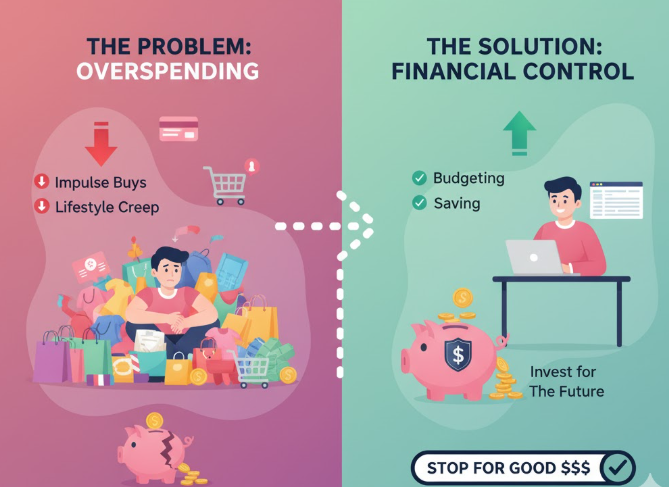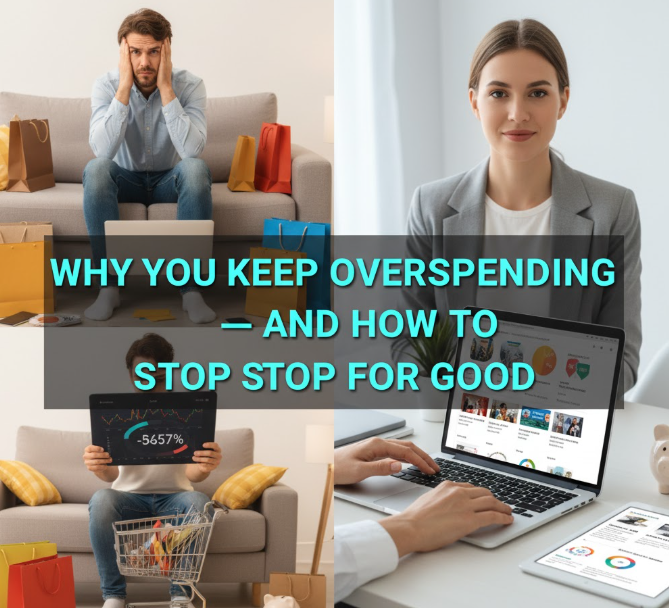Introduction: The Spending Cycle You Can’t Seem to Break
Ever look at your bank balance at the end of the month and wonder, “Where did all my money go?”
You promise yourself that next month will be different — no more impulse buys, late-night online orders, or expensive coffee runs. But somehow, the same thing happens again.
If this sounds familiar, you’re not alone. Overspending isn’t just a money problem — it’s often an emotional, psychological, and even social one. Whether it’s stress, boredom, lifestyle pressure, or lack of financial planning, many of us are caught in the same cycle: earn, spend, regret, repeat.
But here’s the good news: you can break free from overspending permanently.
This article will walk you through why you overspend, how to identify the triggers, and practical strategies that can help you stop — for good.
What Overspending Really Means
Overspending simply means spending more money than you can afford or plan to.
It doesn’t always mean you’re reckless — sometimes, it’s unintentional. You might justify every small expense, but those “harmless” purchases can quickly add up.
Common examples include:
-
Regularly going over your monthly budget
-
Using credit cards to cover daily expenses
-
Shopping to feel better after a bad day
-
Buying things you don’t need because they’re on sale
Quick Reality Check: Are You Overspending?
Ask yourself these questions:
-
Do I often wonder where my paycheck disappeared?
-
Do I use my credit card for wants, not needs?
-
Do I feel guilty after shopping?
-
Do I avoid checking my bank balance?
If you said “yes” to more than two, you likely have overspending habits worth addressing.
The Real Reasons You Keep Overspending
Overspending isn’t just about numbers — it’s about behavior and emotion. Let’s uncover the hidden reasons behind it.
1. Emotional Spending: When Feelings Control Your Wallet
Many people spend money to cope with emotions — happiness, sadness, loneliness, or even boredom. Retail therapy might give a quick dopamine hit, but it fades fast, leaving guilt behind.
Example:
You had a rough day at work, so you buy new clothes online to cheer yourself up. The excitement lasts an hour, but the bill remains for weeks.
Signs of emotional spending:
-
You shop when you’re stressed or upset
-
Purchases feel impulsive
-
You regret buying soon after
-
Shopping feels like a reward
🧠 Pro Tip:
Next time you feel the urge to buy something, pause and ask,
“Do I want this because I need it — or because I feel something right now?”
2. The “I Deserve It” Mindset
After working hard all week, it’s tempting to think, “I deserve to treat myself.”
While there’s nothing wrong with rewards, this mindset can become dangerous when it turns into a habit.
For example:
-
Buying takeout every night because you’re “too tired to cook”
-
Justifying big purchases as “self-care”
Try reframing that thought:
“I deserve financial peace more than another shopping spree.”
3. The Social Comparison Trap
Social media makes it easy to fall into the comparison trap.
Seeing friends, influencers, or colleagues with the latest gadgets, vacations, or outfits can spark spending you can’t truly afford.
What happens:
-
You buy things to “keep up”
-
You feel pressured to maintain an image
-
You measure success by what others own
📱 Reality check:
Social media often shows highlights, not real life. The person with the luxury car might also be drowning in debt.
4. Credit Cards Make It Too Easy
Credit cards are convenient — but they also create a false sense of affordability.
When you tap or swipe, you don’t feel the pain of spending actual cash, which disconnects you from the real cost.
Statistics snapshot:
| Type of Payment | Average Spending Increase |
|---|---|
| Cash | Base |
| Credit Card | +23% higher |
| Mobile Payments | +30% higher |
💡 Tip: Use cash or a debit card for daily purchases — it makes spending feel more “real.”
5. Lack of a Clear Budget
Without a plan, money slips away easily.
A budget gives every dollar a job — without one, every dollar wanders off.
Common signs you lack budgeting:
-
You “wing it” each month
-
You save whatever’s left (which is usually nothing)
-
You can’t track where money goes
Think of a budget as a map for your money — it helps you stay on track and reach your goals faster.
6. Instant Gratification Culture
We live in a world of one-click purchases, express delivery, and “Buy Now, Pay Later.”
Our brains crave quick rewards, but this short-term pleasure harms long-term stability.
Key insight:
Delayed gratification — the ability to wait for rewards — is one of the strongest predictors of financial success.
7. Poor Financial Education
Schools rarely teach how to manage money, credit, or budgeting effectively.
Without financial literacy, people often learn through trial and error — and those errors can be expensive.
But learning money management is a skill anyone can develop, regardless of income or background.
The Hidden Costs of Overspending
Overspending doesn’t just hurt your wallet — it affects your mental health, relationships, and future goals.
Here’s how:
| Area | Impact of Overspending |
|---|---|
| Financial | Debt, lack of savings, high interest payments |
| Emotional | Stress, guilt, anxiety |
| Relational | Conflicts over money, loss of trust |
| Future Goals | Delayed dreams, missed opportunities |
💔 Over time, overspending can make you feel trapped — working harder but never feeling secure.
How to Stop Overspending for Good
Breaking the overspending cycle isn’t about giving up everything you love — it’s about gaining control and confidence over your money.
Here’s a practical, step-by-step plan that actually works.
1. Identify Your Spending Triggers
You can’t fix what you don’t understand.
Start by tracking your spending for 2–4 weeks. Notice when, where, and why you spend.
Common triggers include:
-
Emotional lows or boredom
-
Sales and discounts
-
Peer pressure or social media
-
Payday excitement
📝 Action step:
Keep a small notebook or use an expense-tracking app like:
-
Mint
-
PocketGuard
-
You Need A Budget (YNAB)
2. Create a Realistic Budget — Not a Restrictive One
Budgets fail when they’re too strict.
Instead of cutting out everything fun, assign a “guilt-free” spending category within limits.
Simple 50/30/20 rule:
| Category | Percentage | Description |
|---|---|---|
| Needs | 50% | Rent, bills, groceries |
| Wants | 30% | Entertainment, dining, hobbies |
| Savings/Debt | 20% | Emergency fund, loan payments |
This approach gives structure while allowing flexibility — a sustainable way to manage money.
3. Automate Your Savings
Treat savings like a bill you must pay every month.
Set up an automatic transfer to your savings account right after payday.
Why it works:
-
You save before you’re tempted to spend
-
You remove the decision fatigue
-
You build savings effortlessly
💡 Start small — even 5–10% of your income adds up over time.
4. Use the 24-Hour Rule
Whenever you feel the urge to buy something non-essential, wait 24 hours before purchasing.
Most impulse desires fade quickly once the emotional moment passes.
This simple habit can save you hundreds of dollars a month.

5. Unsubscribe and Unfollow
Emails and social media ads are designed to trigger spending.
Do this today:
-
Unsubscribe from marketing newsletters
-
Unfollow influencer accounts that make you feel inadequate
-
Remove saved cards from online stores
You’ll instantly reduce temptation and regain control over your digital environment.
6. Switch to Cash for Discretionary Spending
Try withdrawing a set amount of cash for weekly expenses like food, entertainment, or personal items.
Once it’s gone — it’s gone.
This physical limitation keeps spending in check and re-establishes the value of money.
7. Replace Shopping with Healthier Habits
If you use shopping to manage emotions, replace it with something that truly nurtures you.
Instead of spending, try:
-
Going for a walk or run
-
Journaling or meditating
-
Calling a friend
-
Starting a hobby that costs little or nothing
Emotional regulation, not restriction, is the key to long-term success.
8. Reframe How You See Money
Money is not your enemy — it’s a tool for freedom.
When you shift from “spending to feel good” to “saving to live well,” your mindset begins to change.
Try creating a vision board with financial goals:
-
Debt-free lifestyle
-
Dream vacation (paid in cash)
-
Emergency fund
-
Retirement peace
This visualization makes the sacrifice worth it.
9. Build an Emergency Fund
Unexpected expenses often lead to panic spending or credit card use.
An emergency fund acts as your financial safety net.
Goal: Save 3–6 months’ worth of essential expenses.
Start small — even $500 can prevent future debt.
10. Reward Yourself the Smart Way
Deprivation leads to rebellion.
Celebrate small wins without breaking your budget.
For example:
-
Hit your savings goal? Treat yourself to a small dinner out.
-
Paid off a credit card? Buy something small — but planned.
You’ll still feel rewarded while staying responsible.
Psychological Tricks That Actually Work
Here are a few proven behavioral hacks to stop overspending:
| Trick | How It Helps |
|---|---|
| Use smaller wallets | Limits how much you can carry and spend |
| Freeze your credit card (literally) | Puts a physical delay on impulse spending |
| Rename your savings account (e.g., “Dream Home Fund”) | Emotional labeling boosts motivation |
| Visual reminders | Keep a photo of your goal near your desk or phone |
| Accountability partner | Share goals with someone who keeps you honest |
Long-Term Mindset Shift: From Consumer to Controller
The goal isn’t to stop spending — it’s to spend with intention.
When you make conscious decisions about your money:
-
You gain confidence
-
You reduce stress
-
You build long-term stability
Financial freedom doesn’t mean never spending — it means being free from regret when you do.
Infographic: The Path from Overspending to Financial Freedom
Each stage builds on the previous one. The key is consistency — not perfection.
Real-Life Example: From Impulsive Buyer to Saver
Sarah’s story:
Sarah used to spend over $400 a month on clothes, coffee, and random online finds.
When she started tracking her expenses, she realized half of them were emotional purchases.
She switched to cash for non-essentials, unfollowed tempting social accounts, and used the 24-hour rule.
Within six months, she saved $2,000 — enough to start her emergency fund.
Her takeaway:
“I thought cutting back meant losing fun. But now, I finally feel in control — and that feels better than anything I could buy.”
Common Myths About Overspending
| Myth | Truth |
|---|---|
| “I don’t make enough money to save.” | Saving is about habits, not income. Start small. |
| “Budgets are too restrictive.” | A good budget gives freedom, not limits. |
| “I need credit cards to build credit.” | You can build credit responsibly by paying on time and keeping balances low. |
| “I’ll start saving later.” | The longer you wait, the harder it gets. Start today. |
Conclusion: Take Back Control of Your Money — and Your Life
Overspending doesn’t make you bad with money — it makes you human.
But staying stuck in that cycle isn’t inevitable.
By identifying your emotional triggers, creating a flexible budget, and developing healthy money habits, you can stop overspending for good — and finally start building the financial freedom you deserve.
Every time you say no to an unnecessary purchase, you’re saying yes to your goals, peace of mind, and a better future.
So, the next time you reach for your wallet, pause and ask yourself:
“Is this helping me move closer to the life I want — or further away from it?”

